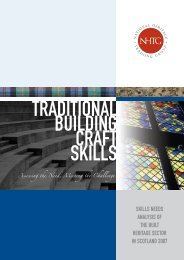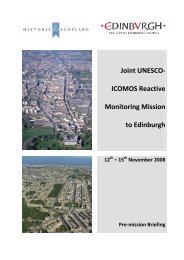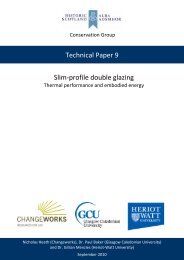Cropmark Archaeology [pdf, 2.4mb] - Historic Scotland
Cropmark Archaeology [pdf, 2.4mb] - Historic Scotland
Cropmark Archaeology [pdf, 2.4mb] - Historic Scotland
You also want an ePaper? Increase the reach of your titles
YUMPU automatically turns print PDFs into web optimized ePapers that Google loves.
CROPMARK<br />
ARCHAEOLOGY
There is a huge amount of buried<br />
archaeology in <strong>Scotland</strong>’s<br />
countryside. Sometimes sites can<br />
be seen from the air even though<br />
they are invisible at ground-level.<br />
Aerial photography has become an<br />
invaluable tool for identifying and<br />
recording sites at risk of destruction,<br />
particularly in the fertile lowlands of<br />
eastern and southern <strong>Scotland</strong>. Deep<br />
ploughing and other agricultural<br />
activities (such as sub-soiling,<br />
drainage, deep ridging, and even<br />
putting up new fences) disturb the<br />
lower levels of soil and destroy buried<br />
traces of past human activities.<br />
Modern cultivation can also help to<br />
reveal the archaeology buried below<br />
the ploughsoil.<br />
collapse and spread and will in time<br />
be buried by natural soil formation.<br />
All of these features will eventually<br />
become invisible on the ground<br />
surface especially after centuries of<br />
soil cultivation, but they can have an<br />
effect that can be seen from the air<br />
in a ploughed field (in the form of<br />
soilmarks) or in a field of crops (in the<br />
form of cropmarks). Visible contrasts<br />
are particularly marked during dry<br />
summers.<br />
The most common prehistoric<br />
features to appear on aerial<br />
photographs in this way are those<br />
connected with houses, enclosures,<br />
burials and ritual.<br />
This artist’s drawing of a section through a field of<br />
growing crops shows the different effects of the ditch<br />
and wall buried beneath the ploughsoil. From the air,<br />
the ditch will show up as a darker band of taller and<br />
greener crops, and the wall as a paler band of shorter<br />
and weaker crops.<br />
Once a site has been abandoned, any<br />
timbers usually rot away and the holes<br />
in which they were set fill up with<br />
decayed wood and soil. A ditch or pit<br />
will start to silt up as soon as it is dug,<br />
if it is not kept open. An old wall will<br />
A timber house may be visible as a<br />
ring of post-holes or a ring-ditch,<br />
while an enclosure may consist of<br />
a narrow trench for a palisade or a<br />
ditch that was once accompanied by<br />
an earthen rampart.
In the growing crop, circular and square outlines can be seen from the air. These are the ditches that once surrounded<br />
mounds of earth over prehistoric burials. (Fife) © Crown Copyright: RCAHMS. Licensor www.rcahms.gov.uk<br />
A burial monument may appear as<br />
a small circular or square ditched<br />
enclosure with a central long pit for<br />
the burial itself. Ritual monuments<br />
take the form of cursus monuments<br />
(very long rectangular ditched<br />
enclosures) and henges (circular<br />
or oval ditched enclosures). Inside<br />
henges there may be pits that once<br />
held circles of timber posts. In<br />
eastern <strong>Scotland</strong>, souterrains often<br />
appear as dark banana-shapes. These<br />
underground storehouses are clues<br />
to the location of the above-ground<br />
houses that they served. Ancient<br />
field-systems and boundaries can be<br />
detected as linear patterns of dark<br />
lines or rows of pits (pit alignments).<br />
Many Roman forts, temporary<br />
camps, signal-towers and roads are<br />
known only as cropmarks on aerial<br />
photographs.<br />
Here the pale patch is where the ploughsoil is thinnest,<br />
and it reveals the dark circles of three prehistoric<br />
roundhouses. Each has a drain running out through<br />
an entrance and traces of postholes and pits inside.<br />
The larger house in the foreground has a long fat<br />
blob adjacent to its south side: this is a souterrain or<br />
underground storehouse. (Perthshire)<br />
© Crown Copyright: RCAHMS.<br />
Licensor www.rcahms.gov.uk
This artist’s reconstruction gives an impression of a<br />
prehistoric roundhouse with an attached souterrain<br />
or underground storehouse. All that may survive of<br />
such a site now are the circular ditch and holes in<br />
which the house walls and posts stood, and the earthfilled<br />
base of the souterrain, although some artefacts<br />
and environmental remains may be preserved.<br />
Systematic field-walking of ploughed<br />
fields can identify surface scatters<br />
of artefacts that also point to the<br />
buried archaeology. Worked flints<br />
and broken pottery are commonly<br />
found from all periods of the past,<br />
along with animal bones and,<br />
close to the coast, marine shells.<br />
Sometimes whole landscapes of<br />
buried multi-period structures can<br />
be seen from the air, which may span<br />
prehistoric, Roman, medieval and<br />
The aerial photograph of this site showed a crop mark<br />
of a large oval enclosure. The excavation, pictured here,<br />
revealed the details of the houses, pits and ditches of a<br />
multi-period prehistoric settlement. (East Lothian)<br />
© Crown Copyright: RCAHMS.<br />
Licensor www.rcahms.gov.uk<br />
later times. In Fife and the Lothians,<br />
cemeteries of Early Christian graves<br />
from the 6th to 9th centuries AD<br />
appear as regular clusters of long<br />
dark pits aligned east-west. Medieval<br />
homesteads surrounded by moats<br />
(water-filled ditches) and the<br />
formal gardens belonging to castles<br />
and stately homes are among the<br />
later monuments that have been<br />
identified by aerial photography.<br />
The underlying geology (subsoil<br />
and bedrock) also has an effect<br />
on what can be seen on aerial<br />
photographs. Sometimes it masks<br />
the archaeological evidence and<br />
other times it enhances it. Excavation<br />
of cropmark sites often reveals<br />
a complexity of archaeological<br />
remains that is not visible on aerial<br />
photographs. The richness of these<br />
sites is vulnerable to deep ploughing,<br />
as are many other sites that may not<br />
be visible from the air.
TIME-LINE<br />
End of the last Ice Age 12,500<br />
Wildlife colonises land<br />
Mesolithic hunting settlers 8500<br />
Neolithic farming settlers 4000<br />
3000<br />
Metal technology<br />
(gold, copper) 2000<br />
Climate deteriorating 1000<br />
Fortifications begin<br />
Flint scatters<br />
Shell mounds, rock shelters<br />
Chambered tombs and houses<br />
Cupmarked rocks<br />
Stone circles, henges, and<br />
standing stones<br />
Burial mounds and short cists<br />
Hut-circles<br />
Burnt mounds<br />
Hillforts<br />
Iron-working technology 500<br />
200<br />
BC<br />
AD<br />
Roman army in <strong>Scotland</strong> 79<br />
Waning of Roman influence 200<br />
400<br />
Introduction of Christianity<br />
Picts, Gaels, Britons and Anglians 600<br />
Start of the Viking Age<br />
800<br />
Emergence of Scottish nation<br />
1000<br />
1100<br />
First burghs<br />
1200<br />
1500<br />
Reformation of the Church<br />
1600<br />
Agricultural improvements &<br />
Industrial Revolution 1800<br />
1900<br />
Two World Wars<br />
2000<br />
Crannogs<br />
Duns, brochs, wheelhouses, and<br />
earth-houses<br />
Roman camps, forts and<br />
roads, Antonine Wall<br />
Long cist graves<br />
Early Christian and Pictish<br />
carved stones, chapels<br />
Pagan Viking graves and<br />
settlements<br />
Stone-built churches<br />
Mottes, abbeys, stone-built<br />
castles<br />
Tower-houses<br />
Deserted villages and farms<br />
Coal mines and heavy<br />
industries<br />
Gun batteries and airfields<br />
FRONT COVER PHOTOGRAPH:<br />
On a plateau above the steep slopes that border the river below are two prehistoric forts. Their ditches show up as dark<br />
arcs in the growing crop, but their ramparts have long since been ploughed flat. (Berwickshire) .<br />
© Crown Copyright: RCAHMS. Licensor www.rcahms.gov.uk
For advice and further information, please contact<br />
<strong>Historic</strong> <strong>Scotland</strong><br />
Longmore House, Salisbury Place<br />
Edinburgh EH9 1SH<br />
Tel: 0131 668 8766<br />
Email: hs.schedulingteam@scotland.gsi.gov.uk<br />
www.historic-scotland.gov.uk<br />
<strong>Historic</strong> <strong>Scotland</strong> is the agency within<br />
the Scottish Government responsible<br />
for administering the legislation<br />
that protects ancient monuments<br />
(buildings, ruins, archaeological sites<br />
and landscapes). It provides general<br />
advice on the presentation and<br />
protection of <strong>Scotland</strong>’s heritage.<br />
<strong>Historic</strong> <strong>Scotland</strong>’s Education Service<br />
encourages the use of the built heritage<br />
as a learning and teaching resource.<br />
Over 300 historic properties looked<br />
after by <strong>Historic</strong> <strong>Scotland</strong> are open to the<br />
public for enjoyment and education.<br />
For further information, including free<br />
leaflets, telephone 0131 668 8600.<br />
Our data service website contains details of scheduled monuments<br />
and has GIS datasets available to download:<br />
http://data.historic-scotland.gov.uk<br />
The following leaflets are available from <strong>Historic</strong> <strong>Scotland</strong>:<br />
Scheduled ancient monuments: a guide<br />
for owners, occupiers and land managers<br />
Managing <strong>Scotland</strong>’s archaeological<br />
heritage<br />
Grants for Ancient Monuments: a guide<br />
to grants available for the preservation,<br />
maintenance and management of<br />
ancient monuments<br />
<strong>Archaeology</strong> on farm and croft (produced<br />
jointly with <strong>Archaeology</strong> <strong>Scotland</strong>)<br />
<strong>Scotland</strong>’s listed buildings: a guide for<br />
owners and occupiers<br />
The carved stones of <strong>Scotland</strong>: a guide to<br />
helping in their protection<br />
Metal detecting - yes or no? Metal<br />
detecting, scheduled ancient monuments<br />
and the law<br />
A leaflet on Treasure Trove in <strong>Scotland</strong> is<br />
available from the National Museums<br />
of <strong>Scotland</strong>, Edinburgh<br />
A number of <strong>Historic</strong> <strong>Scotland</strong> Technical<br />
Advice Notes, on topics such as the<br />
use of lime mortars, the conservation<br />
of thatching and stonecleaning, are<br />
available. Catalogue from and orders to:<br />
<strong>Historic</strong> <strong>Scotland</strong> Conservation Group<br />
Tel: 0131 668 8638<br />
e-mail:<br />
hs.cgpublications@scotland.gsi.gov.uk<br />
This information leaflet is one of a series<br />
produced by <strong>Historic</strong> <strong>Scotland</strong>.<br />
Text written by Anna Ritchie<br />
Illustrations drawn by Alan Braby<br />
© Crown Copyright: <strong>Historic</strong> <strong>Scotland</strong><br />
(2011).


![Cropmark Archaeology [pdf, 2.4mb] - Historic Scotland](https://img.yumpu.com/22301364/1/500x640/cropmark-archaeology-pdf-24mb-historic-scotland.jpg)
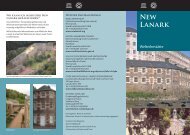
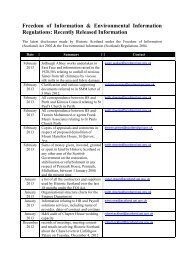
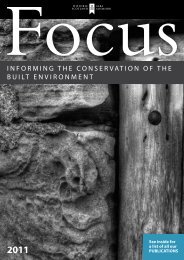
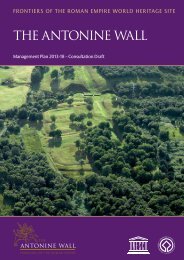
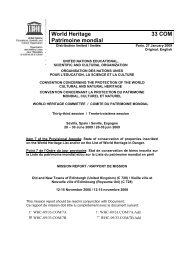
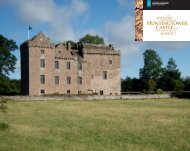



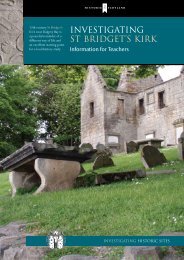
![Elgin Cathedral Wedding Brochure [pdf, 544kb] - Historic Scotland](https://img.yumpu.com/22301571/1/190x151/elgin-cathedral-wedding-brochure-pdf-544kb-historic-scotland.jpg?quality=85)

